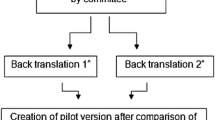Abstract
Patients with facial paralysis not only suffer from asymmetry of the face, but also from problems with eating and drinking. To demonstrate that these patients have many problems with activities such as eating and drinking, we examined 17 outpatients with a unilateral peripheral facial paralysis for the presence of problems in these functions. To collect data, all patients completed a questionnaire concerning the problems they had directly following onset of the paralysis and at the moment of this study. In addition, they were examined to determine the severity of the paralysis, the problems with eating and drinking, their experiences regarding impairments and disabilities, and the compensatory behavior. The result of the study is a portrayal of problems and conscious or unconscious compensations. Furthermore, we concluded that the Sunnybrook Facial Grading System score does not predict the number of problems in eating and drinking, the number of compensations, and the emotional impact. Significant correlations are found only between various scores on Visual Analog Scales and the number of compensatory actions. Patients differ in how they experience the extensive problems due to the facial paralysis and in the extent to which they are successful in adaptation. Consulting a speech therapist for treatment of functional problems is a meaningful adjunct to regular therapy. The treatment of deglutition disorders can be best based upon the detailed information of the questionnaire and the examination of eating, drinking, and compensatory behavior.



Similar content being viewed by others
References
CHG Beurskens MEJ van Rossum–Herraets JJ Manni J-PA Nicolai (1998) ArticleTitlePhysiotherapy following a hypoglossal-facial nerve interpositional jump graft. J Clin Rehabil 1 37–45
PP Devriese T Schumacher A Scheide RH De Jongh JM Houtkoper (1990) ArticleTitleIncidence, prognosis and recovery of Bell’s palsy. A survey of about 1000 patients (1974–1983). Clin Otolaryngol 15 15–27 Occurrence Handle1:STN:280:By%2BB3MzptVE%3D Occurrence Handle2323075
C Beurskens (1988) The functional rehabilitation of facial muscles and facial expression. D Castrol (Eds) Facial Nerve, Proceedings of the Sixth International Symposium of the Facial Nerve. Kugler & Ghedini Publications Amsterdam 509–511
PP Devriese (1998) ArticleTitleTreatment of sequelae after facial paralysis: a global approach. J Laryngol Otol 112 429–431 Occurrence Handle1:STN:280:DyaK1cvhvFKjtw%3D%3D Occurrence Handle9747468
JM VanSwaeringen JS Brach (1966) ArticleTitleThe Facial Disability Index: reliability and validity of a disability assessment instrument for disorders of the facial neuromuscular system. Phys Ther 76 1288–1300
RM Miller (1997) Clinical examination for dysphagia. ME Groher (Eds) Dysphagia, diagnosis and Management, 3rd ed. Butterworth-Heinemann Boston 169–189
Y Seçil I Aydoğdu C Ertekin (2002) ArticleTitlePeripheral facial palsy and dysfunction of the oropharynx. J Neurol Neurosurg Psychiatry 72 391–393 Occurrence Handle11861704
TM McCulloch DM Jalle HT Hoffman (1998) Diseases and operation of head and neck structures affecting swallowing. AL Perlman K Schulze-Delrieu (Eds) Deglutition and its Disorders. Singular Publishing Group London 343–382
JS Brach JM VanSwearingen A Delitto PC Johnson (1997) ArticleTitleImpairment and disability in patients with facial neuromuscular dysfunction. Otolaryngol Head Neck Surg 117 315–321 Occurrence Handle1:STN:280:ByiH2sbntVw%3D Occurrence Handle9339789
PP Devriese J Bronk (1977) Non-surgical rehabilitation of facial expression. U Fisch (Eds) Nerve Surgery. Kugler Medical Publication Amstelveen 290–294
BG Ross G Fadet JM Nedzelski (1996) ArticleTitleDevelopment of a sensitive clinical facial grading system. Otolaryngol Head Neck Surg 114 380–386 Occurrence Handle1:STN:280:BymB2czis1I%3D Occurrence Handle8649870
DL Steiner GR Norman (2001) Visual analogue scales. Health Measurement Scales. Oxford University Press New York 32–33
Acknowledgements
We would like to thank Judith de Bok, Laska Könning, Geertje Visscher, and Gerdine Vos of the HAN University of Professional Education for collecting data.
Author information
Authors and Affiliations
Corresponding author
Rights and permissions
About this article
Cite this article
de Swart, B.J., Verheij, J.C. & Beurskens, C.H. Problems with Eating and Drinking in Patients with Unilateral Peripheral Facial Paralysis . Dysphagia 18, 267–273 (2003). https://doi.org/10.1007/s00455-003-0011-0
Issue Date:
DOI: https://doi.org/10.1007/s00455-003-0011-0




